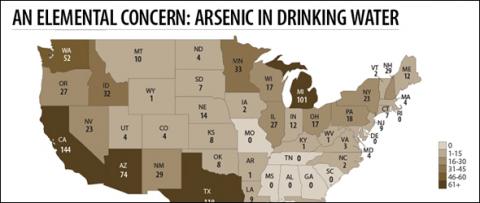Nearly 20 million people in China could be exposed to water contaminated with arsenic, a study suggests.
Scientists used information about the geology of the country to predict the areas most likely to be affected by the poison.
The report is published in the journal Science.
Arsenic occurs naturally in the Earth's crust, but if it leaches into groundwater, long-term exposure can cause serious health risks.
These include skin problems and cancers of the skin, lungs, bladder and kidney.
Geological maps
Until now, estimating the scale of arsenic contamination in large countries has been difficult.
China is thought to have more than 10 million drinking wells, and each needs to be screened to establish whether any toxic compounds are present. This process could take decades.
Instead, researchers from Switzerland and China looked at geological maps of the country.
What it is very important to do is to go to the areas that are hotspots and screen those first”
Dr Annette Johnson, from the Swiss Federal Institute of Aquatic Science and Technology (EAWAG) and a co-author of the study, explained: "In the last few years the amount of geospatial information - electronic maps - that's become available is large. You have information such as climate data, land use, and distance to the river or elevation."
Using this information, and by looking at the types of rocks present in the country, and in particular their age, the researchers pinpointed the regions where the toxic element is most likely to be found.
Their findings suggest that 19.6 million people in China could be exposed to unsafe levels in their drinking water, including some living in areas areas not previously thought to be at risk.

Dr Johnson told the BBC World Service programme Science in Action: "They are areas along river basins where there is irrigation and agriculture, including areas that were known previously such as the Huhhot basin in Inner Mongolia, but there are also new areas in the central Sichuan province and along the east coast."
The researchers say the findings could help the Chinese authorities with their well-screening programmes.
Dr Johnson explained: "What it is very important to do is to go to the areas that are hotspots and screen those first. The chances are you will find more contaminated wells than wells that are not contaminated.
"And in the other areas, you still have to make sure you do screening for arsenic, but it is probably not such a high priority."
Wells that are contaminated could be either treated or taken out of use, she added.
The researchers believe this new prediction method could used elsewhere around the world.
Arsenic contamination of groundwater is found in central Europe, South America, parts of the US and Asia.
But one country that could benefit is Bangladesh, where arsenic poisoning has been described by the World Health Organization as a "public health emergency".
It is estimated that between 35 million and 77 million people there are at risk of drinking contaminated water.


Spread the word